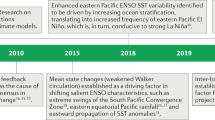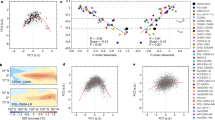Abstract
The potential for the mean climate of the tropical Pacific to shift to more El Niño-like conditions as a result of human induced climate change is subject to a considerable degree of uncertainty. The complexity of the feedback processes, the wide range of responses of different atmosphere–ocean global circulation models (AOGCMs) and difficulties with model simulation of present day El Niño southern oscillation (ENSO), all complicate the picture. By examining the components of the climate-change response that projects onto the model pattern of ENSO variability in 20 AOGCMs submitted to the coupled model inter-comparison project (CMIP), it is shown that large-scale coupled atmosphere–ocean feedbacks associated with the present day ENSO also operate on longer climate-change time scales. By linking the realism of the simulation of present day ENSO variability in the models to their patterns of future mean El Niño-like or La Niña-like climate change, it is found that those models that have the largest ENSO-like climate change also have the poorest simulation of ENSO variability. The most likely scenario (p=0.59) in a model-skill-weighted histogram of CMIP models is for no trend towards either mean El Niño-like or La Niña-like conditions. However, there remains a small probability (p=0.16) for a change to El Niño-like conditions of the order of one standard El Niño per century in the 1% per year CO2 increase scenario.













Similar content being viewed by others
References
Achutarao K, Sperber KR in collaboration with the CMIP modeling groups (2002) Simulation of the El Niño southern oscillation: results from the coupled model intercomparison project. Clim Dyn 19:191–209
Allen MR, Stainforth DA (2002) Towards objective probabilistic climate forecasting. Nature 419:228
Basnett TA, Parker DE (1997) Development of the global mean sea level pressure data set GMSLP2. Hadley Centre Climate Research Technical Note CRTN 79
Buizza R, Miller M, Palmer TN (1999) Stochastic representation of model uncertainties in the ECMWF EPS. Quart J R Met Soc 125:2887–2908
Cane MA, Clement AC, Kaplan A, Kushnir Y, Pozdnyakov D, Seager SE, Zebiak SE, Murtugudde R (1997) Twentieth century sea surface temperature trends. Science 275:957–960
Clement A, Seager R (1999) Climate and tropical oceans. J Clim 12:3383–3401
Collins M (2000) Understanding uncertainties in the response of ENSO to greenhouse warming. Geophys Res Lett 27(21):3509–3513
Corti S, Molteni F, Palmer TN (1999) Signature of recent climate change in frequencies of natural atmospheric circulation regimes. Nature 398:799–802
Covey C, AchutaRao KM, Cubasch U, Jones P, Lambert SJ, Mann ME, Phillips TJ, Taylor KE (2003) An overview of the results of the coupled model intercomparison project. Global Planetary Change 37:103–133
Cox PM, Betts RA, Jones CD, Spall SA, Totterdell I (2000) Acceleration of global warming due to carbon cycle feedbacks in a coupled climate model. Nature 408:184–187
Cox PM, Betts RA, Collins M, Harris P, Huntingford C, Jones CD (2004) Amazon dieback under climate-carbon cycle projections for the 21st century. Theor Appl Climatol 78:137–156. DOI: 10.1007/s00704-004-0049-4
Cubasch U, Meehl GA et al (2001) The scientific basis. Contribution of working group I to the third assessment report of the Intergovernmental Panel on Climate Change. Cambridge University Press, Cambridge
Ebbesmeyer CC, Cayan DR, McLain DR, Nichols FH, Peterson DH, Redmond KT (1991). 1976 step in the Pacific climate: forty environmental changes between 1968–1975 and 1977–1984. In: Betancourt JL, Sharp VL (eds) Proceedings of the 7th annual Pacific climate (PACLIM) workshop, April 1990. California Department of Water Resources. Interagency Ecological Studies Program Technical Report 26
Graham NE (1994) Decadal-scale climate variability in the tropical and North Pacific during the 1970s and 1980s: observations and model results. Clim Dyn 10:135–162
Guilderson TM, Schrag D (1998) Abrupt shift in subsurface temperature in the tropical Pacific associated with changes in El Niño. Science 281:240–243
Jin F-F, Hu Z-Z, Latif M, Bengtsson L, Roeckner E (2001) Dynamical and cloud–radiation feedbacks in El Niño and greenhouse warming. Geophys Res Lett 28:1539–1542
Knutson TR, Manabe S (1995) Time-mean response over the tropical Pacific to increased CO2 in a coupled ocean–atmosphere model. J Climate 8:2181–2199
Kuntson TR, Manabe S (1998) Model assessment of decadal variability and trends in the tropical Pacific ocean. J Climate 11:2273–2296
Latif M, Roeckner E, Mikolajewicz U, Voss R (2000) Tropical stabilization of the thermohaline circulation in a greenhouse warming simulation. J Climate 13:1809–1813
Li T, Hogan TF, Chang C-P (2000) Dynamic and thermodynamic regulation of ocean warming. J Atmos Sci 57:3353–3365
McDonald RE, Bleaken DG, Cresswell DR, Pope VD, Senior CA (2004) Tropical storms: representation and diagnosis in climate models and the impacts of climate change. Clim Dyn (in press). DOI:10.1007/s00382-004-0491-0
Meehl GA, Washington WM (1999) El Niño-like climate change in model with increased atmospheric CO2 concentrations. Nature 382:56–60
Meehl GA, Collins W, Boville B, Kiehl JT, Wigley TML, Arblaster JM (2000) Response of the NCAR climate system model to increased CO2 and the role of physical processes. J Climate 13:1879–1898
Noda A, Yoshimatsu K, Yukimoto S, Yamahuchi K, Yamaki S (1999) Relationship between natural variability and CO2-induced warming pattern: MRI AOGCM experiment. In: 10th symposium on global change studies, American Meteorological Society Publication
Pierrehumbert RT (1995) Thermostats, radiator fins, and the local runaway greenhouse. J Atmos Sci 52:1784–1806
Rayner NA, Parker DE, Horton EB, Folland CK, Alexander LV, Rowell DP, Kent EC, Kaplan, A (2004) Globally complete analyses of SST, sea-ice and night marine air temperature, 1871–2000. J Geophys Res (in press)
Senior CA (1999) Comparison of mechanisms of cloud–climate feedbacks in a GCM. J Climate 12:1480–1489
Sun, DZ, Liu, Z (1996) Dynamic ocean–atmosphere coupling: a thermostat for the tropics. Science 272:1148–1150
Timmermann A, Oberhuber J, Bacher A, Esch M, Latif M, Roeckner E (1999) Increased El Niño frequency in a climate model forced by future greenhouse warming. Nature 398:694–696
Trenberth KE, Hurrell JW (1994) Decadal atmosphere–ocean variations in the Pacific. Clim Dyn 9:303–319
Xie P, Arkin PA (1997) Global precipitation: a 17-year monthly analysis based on gauge observations, satellite estimates and numerical model outputs. Bull Am Met Soc 78:2539–2558
Acknowledgements
This study could not have been performed without the contributions of all the CMIP participants and the excellent work of the PCMDI CMIP team. This work was supported by the UK Department of the Environment, Food and Rural Affairs under Contract PECD/7/12/37 and by the UK National Environment Research Council under the COAPEC programme.
Author information
Authors and Affiliations
Consortia
Corresponding author
Rights and permissions
About this article
Cite this article
Collins, M., The CMIP Modelling Groups (BMRC (Australia), CCC (Canada), CCSR/NIES (Japan), CERFACS (France), CSIRO (Austraila), MPI (Germany), GFDL (USA), GISS (USA), IAP (China), INM (Russia), LMD (France), MRI (Japan), NCAR (USA), NRL (USA), Hadley Centre (UK) and YNU (South Korea)). El Niño- or La Niña-like climate change?. Clim Dyn 24, 89–104 (2005). https://doi.org/10.1007/s00382-004-0478-x
Received:
Accepted:
Published:
Issue Date:
DOI: https://doi.org/10.1007/s00382-004-0478-x




